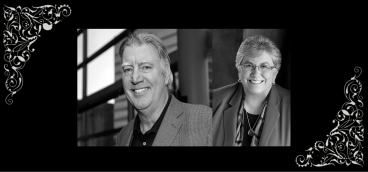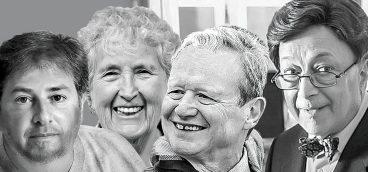Conway, Buford, Oshry, Morby, Moriarity, O’Reilly, Nutting, Ochester, Eberle, Courtney

Tom Conway, 71
International president of United Steelworkers since 2019, Conway was committed to making things in America and remained unwilling to accept that globalization was better. He tried to make changes in manufacturing that would lead to a cleaner environment and worker health and safety. A legendary negotiator who believed in the union ideal of “stronger together,” he advocated for fair trade as he navigated multiple industry crises. He also expanded union representation — today the USW represents 850,000 workers in industries including metals, mining, health care and education. President Biden considered him a personal friend.
Earl Buford, 81
The former Pittsburgh police chief was the second minority to lead the department in its 166-year history. He joined the force in 1968 and served as a patrolman, detective, sergeant, commander and assistant chief of investigations before becoming chief in 1992. After his retirement, he worked as a security representative for the NFL. Buford loved the water and owned many boats over the years, which he used on Pittsburgh’s rivers.
Elliott Oshry, 78
Oshry seemed to know everyone — in part it was his job, but also his personality. As executive VP of Ketchum, he was a part of its fundraising council since 1973 and earned many philanthropic awards through the American Fundraising Professionals. He served on the boards of the Pittsburgh Symphony, Allies Health + Wellness, the Jewish Association on Aging and the Fred Rogers Co, among others. He was a consultant to KidsVoice, helping abused children.
Jeff Morby, 86
An arts patron, playwright, and businessman turned philanthropist, Morby had insatiable curiosity and a drive to leave the world a better place. He did that most notably by co-founding, in 2004, the Cure Alzheimer’s Fund with his wife of 64 years, Jacqui. Its goal was eliminating Alzheimer’s disease and relieving the physical, emotional, and financial burden of the illness. Morby contributed major funding as well as leadership, connecting the most progressive researchers from around the world to collaborate on finding a cure.
Dr. Richard Moriarity, 83
Mr. Yuk was the brainchild of the Lawrenceville native who built the Pittsburgh Poison Center and created its beloved mascot. A pediatrician, Dr. Moriarity was chief resident at Children’s Hospital in the late ‘60s when he was asked to modernize and revamp poison control. He raised funding, assembled a staff experienced in toxicology and kick-started data collecting, which didn’t then exist, and grew it into the national poison database. Mr. Yuk was inspired by the faces kids made in reaction to the angry green face that became a national symbol. He was active on the boards of the Carnegie Museum of Natural History and Pittsburgh Public Theater.
Lady Chryssanthie “Chryss” O’Reilly, 73
The Greek shipping heiress wife of Heinz CEO Tony O’Reilly and an accomplished horse breeder, she was glamour personified during her time in Pittsburgh in the 1990s. The couple entertained often at their Fox Chapel home, with guests including Paul Newman and Nelson Mandela. Once the second wealthiest woman in England, she was gracious and unassuming and would let the curious try on her $2.6 million diamond, the same one Aristotle Onassis gave to Jackie Kennedy. She raised $4 million for the American Ireland Fund of Pittsburgh, gave $1 million to United Way and several million to the Pittsburgh Cultural Trust, which named the O’Reilly Theater in her husband’s honor. She was also active on numerous boards including AGH and the International Poetry Forum.
G. Ogden Nutting, 87
His newspaper empire stretched across 18 states and included more than 50 daily publications, but locally Nutting is best known for his 1996 investment that helped to keep the Pirates in Pittsburgh. His son, Bob, now leads the organization. Nutting was the longtime publisher of Ogden Newspapers Inc. and spent more than 60 years in various roles with the company. His grandfather, H.C. Ogden, founded The Wheeling Evening News in 1890. Active in his hometown of Wheeling, his philanthropy touched numerous organizations. He received a Distinguished West Virginian award by the governor in 2005 and was inducted two years later into West Virginia University’s Order of Vandalia for service to the state.
Ed Ochester, 83
The chair of Pitt’s Creative Writing Program for 28 years, he was known as the father of Pittsburgh poets for the many he mentored as a teacher and longtime editor of the Pitt Poetry Series. He oversaw the publication of hundreds of award-winning collections, including many by minority poets. A poet himself, Ochester published 19 collections including the 1993 anthology “The Pittsburgh Book of Contemporary American Poetry,” “Changing the Name to Ochester” and “Dancing on the Edges of Knives,” which won the 1973 Devins Award for Poetry. He received fellowships in poetry from the National Endowment for the Arts and the Pennsylvania Council on the Arts.
Ed Eberle, 78
The Tarentum-born ceramicist, sculptor and artist had works in more than 25 museums across the world, including the Smithsonian American Art Museum and the Carnegie Museum of Art. With an MFA in ceramics from Alfred University, Eberle taught at the Philadelphia College of Art before taking over the ceramics program at Carnegie Mellon in 1975. He created in different mediums and in 1980 had his first solo exhibition at the Carnegie with installation art, sculptures and drawings. He was known for his use of terra sigillata, a black, glaze-like clay, which brought him great commercial success. His former studio in Homestead will be used for fine artists who work in ceramics.
Tom Courtney, 90
The Fordham University graduate won the 800-meter race by one-tenth of a second in the 1956 Melbourne Olympics, capturing the gold medal for the U.S. Courtney was a 23-year-old Army private at the time and not the favorite going into the games — that distinction went to Pitt senior Arnie Sowell. Courtney won a second gold medal by anchoring the U.S. 4×400-meter relay team. He credited his win — and many others as a student athlete, where he dominated national titles from 1954-1958 — to training by running downhill. He went on to work for an investment firm in Pittsburgh.












